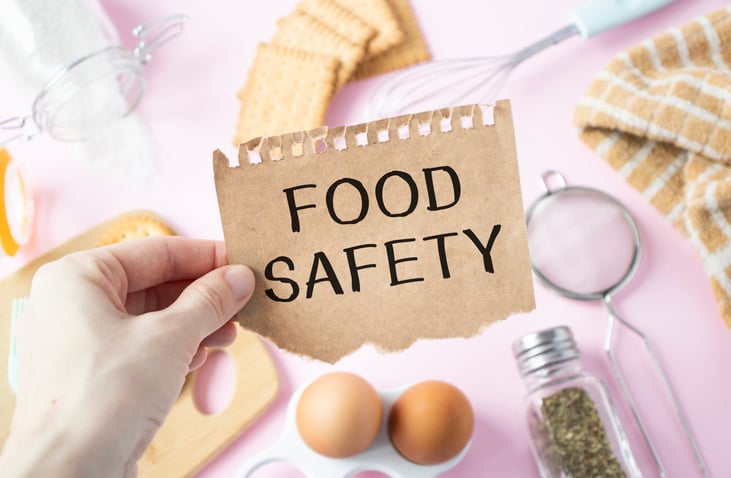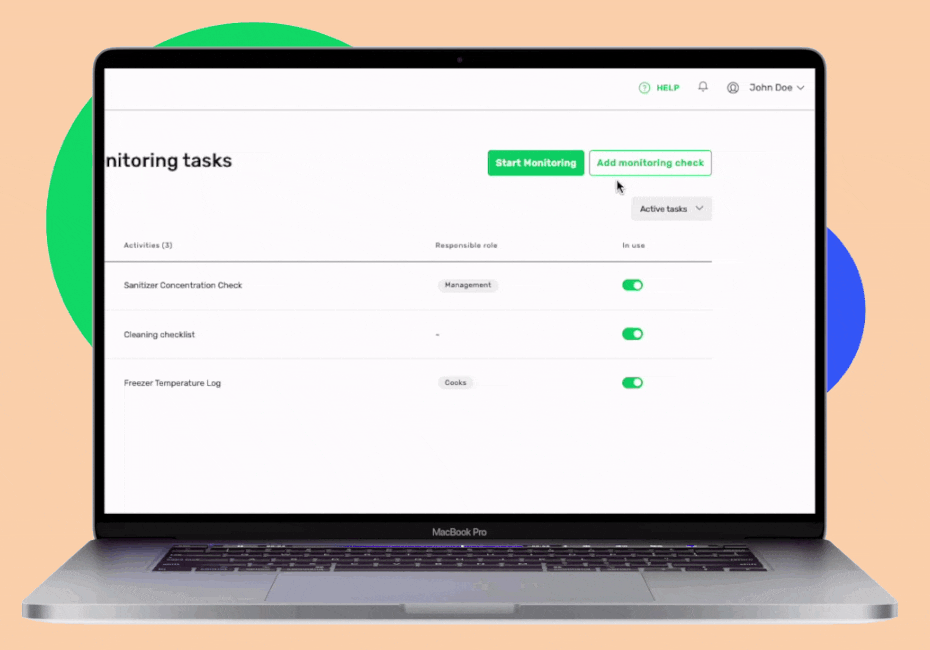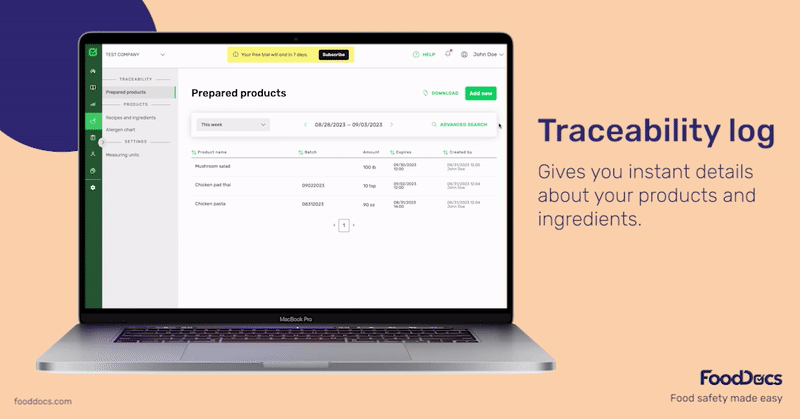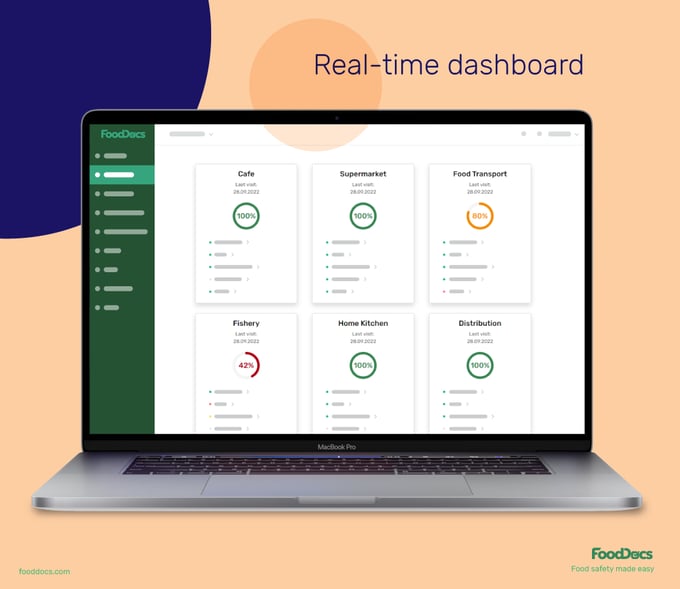Why Is Food Safety Important In Healthcare? Healthcare Leaders Guide
Learn challenges healthcare foodservice teams face today and key food safety practices to protect vulnerable patients. Get a free healthcare leader...
There have been many efforts by the food industry stakeholders to ensure food safety throughout the global food supply chain. The Global Food Safety Initiative (GFSI) has emerged as a key player in this mission. This organization was made by major stakeholders in the food industry to benchmark standards on food safety and allow for the production of safer food for consumers.
In this article, we discuss the fundamentals of GFSI, explore its importance in the food industry, and explain the steps and strategies for obtaining GFSI certification. Let’s dive in!
Learn more about the GFSI certification program and how can our innovative software help you efficiently achieve a significant label for your business.
WHAT WE'LL COVER:
The GFSI is a program launched by an organization of leading food retailers, manufacturers, and food safety experts.
One of the main objectives of the program is to reduce food safety hazards and potential risks within the food supply chain. It achieves this by recognizing and benchmarking existing food safety standards and certifications against a set of internationally recognized criteria. This enhances the assurance of food safety throughout the entire supply chain on a global level.
Different stakeholders of the food supply chain often seek GFSI recognition to improve product quality and show their commitment to food safety. There are different schemes available for food manufacturers, retailers, food service providers, and suppliers as part of the program.

GFSI schemes are the various food safety standards and certification programs recognized by the organization. These programs have different focus points for evaluating food safety and quality.
Certification schemes approved by the GFSI are referred to as GFSI-recognized or GFSI-benchmarked schemes. They contain accredited frameworks for food producers, manufacturers, retail sellers, and food service companies for implementing an effective food safety management system.
Here are seven popular GFSI-recognized schemes in the food industry:
It’s important to note that schemes have undergone a comprehensive benchmarking process before becoming GFSI-recognized. By complying with one of these GFSI-recognized schemes, your food business will be seen as strongly committed to producing high-quality and safe food.
Fortunately, FoodDocs software would be a huge help if you're trying to comply with these GFSI-recognized schemes efficiently. You can use it to easily set up a comprehensive and smart Food Safety Management System.
Keep in mind that a complete monitoring system is a major food safety requirement of most GFSI schemes. With the help of our smart software, you can have a complete system for monitoring your entire production process set up in no time. You can also document your compliance with robust food safety practices using our automatically generated monitoring tasks.
GFSI recognition offers many benefits to food businesses. Here are six important ones to be aware of:
To put it briefly, GFSI recognition opens a wide range of market opportunities for food businesses.
GFSI recognition portrays your business as an organization that takes food safety seriously to investors, key stakeholders, and partners. It also helps promote a culture of food safety and quality throughout the supply chain, allowing you to produce high-quality and safe products that customers love.

Choosing the appropriate GFSI scheme for your business depends on several factors.
The goals of your chosen scheme must align with those of your food business and must be compatible with the appropriate food safety regulations.
Consider the following factors when choosing a GFSI scheme:
Remember, understanding what your business needs to ensure food safety is important when choosing a GFSI-recognized scheme. This will also help you determine which areas to focus on for improvement.
GFSI compliance refers to a business’ adherence to food safety requirements established by a GFSI-recognized scheme. It shows that your business has implemented comprehensive food safety management systems and other strict food safety standards.
It also shows that your business has established procedures to reduce the risks of food hazards and is continuously working toward improving your management system.
Compliance involves aligning your food safety practices and management system with one of the GFSI-recognized standards, such as SQF, BRCGS, FSSC 22000, or IFS. And companies undergo regular audits by accredited certification bodies to achieve and maintain it. These audits assess an organization's adherence to the chosen GFSI-recognized standard.
The good news is that you can easily achieve and maintain GFSI compliance with the help of FoodDocs' intuitive Food Safety Management System, which lets you set up a comprehensive monitoring system in just 15 minutes.
The monitoring system that you will get includes automatically generated monitoring tasks, which saves a significant amount of time. You can also conduct in-house audits and inspections by using our Food Safety App and use the gathered information to improve your operations.
Although all standards for the different GFSI-recognized schemes focus on safety and quality, there are a few variations in focus and compliance requirements.
But still, there are several common elements and principles that food businesses must comply with as part of any GFSI certification scheme. These include:
Keep in mind that these are general categories of common GFSI requirements. International standards may have additional, industry-specific requirements. For example, production-specific schemes will require minimum manufacturing controls, which may not be present in food service-specific schemes. So it is important for any food business seeking GFSI certification to review the standards and requirements of each scheme.
GFSI certification is a globally recognized food safety certification that shows your business’ compliance with food safety standards benchmarked by the GFSI. It assures consumers and stakeholders that a food producer or supplier follows rigorous food safety practices, reducing the risk of contamination and ensuring product safety.
It’s important to note that the GFSI does not provide the certificates directly. Instead, it is provided by one of the GFSI-recognized schemes.
The voluntary program involves evaluating your business's food safety management system, recordkeeping system, and compliance with standards through a comprehensive inspection and auditing. This is conducted by a team of food safety experts.
You can use FoodDocs' intuitive Food Safety Management System to comply with the certification requirements of all major GFSI-recognized schemes. With the help of our smart software, you can easily set up a system for monitoring your food safety compliance and ensuring commitment to global standards.
You’ll get a complete and customizable Food Safety Management System when you sign up for our services or book a demo with us. You will also explore a real-time dashboard that you can use to oversee your daily food safety progress and save time on micromanaging your team.
When a food business gets the status of "GFSI-certified," it means they have successfully passed the assessment and audit scheme of a GFSI-recognized system.
In other words, it means that the business has demonstrated having a strong food safety management system and compliance with global standards.
It's important to remember that the GFSI does not develop or administer food safety standards. Instead, it benchmarks and approves existing standards developed by organizations like BRC, SQF, FSSC 22000, and IFS.
Therefore, when a business is GFSI-certified, it means they have met the specific requirements of one of these recognized standards, which has been independently verified.
Some GFSI schemes may cost as low as $1000, while others charge anywhere between $5000 and $7500.
The exact cost of your GFSI certification will vary based on several factors, such as the certification scheme you chose, the complexity of your operations, your location, the auditing services available in your region, and whether or not you hire a consultant.

It’s a good idea to obtain quotes from the available certification bodies or auditing firms to understand the exact costs your business will have to pay.
GFSI certification can take anywhere between five months and a year, depending on how fast you can comply with the necessary requirements.
The time will also depend on the general findings during the certification audit, the complexity of your operations, and how fast you address the food safety issues raised by your inspector.
Here are nine key factors that will determine your GFSI certification time:
Planning, conducting a gap analysis, and implementation take the most time out of all GFSI certification processes. If you want to cut the time needed to achieve your GFSI certification significantly, consider establishing a food safety management system, training your team, documenting all your food safety tasks, and establishing a traceability program using FoodDocs. You can do all of this within 15 minutes using our tool.
A GFSI audit is an assessment stage of your business’s food safety management system and practices to determine your level of compliance.
The main objective of a GFSI food safety audit is to determine if a food business meets the requirements of a GFSI-recognized scheme and effectively manages food safety risks throughout its supply chain.
The third-party audit will be performed by an expert or representative acknowledged by the scheme.
Here is a GFSI audit checklist to help you easily pass the audit and get certified quickly:
Once your business passes a GFSI audit using this checklist, it will be recognized by international organizations, setting you up for global success.
Although internationally recognized, GFSI standards differ based on their applications and regional popularity.
For example, the SQF certification — which focuses on food retailers and manufacturers – is the most popular scheme in the United States. On the other hand, IFS (which focuses on senior management responsibility, resource management, pre-planning, and productivity) is more popular in Europe.
But keep in mind that all GFSI schemes are globally recognized and it’s important to choose one based on its application instead of popularity.
A GFSI consultant is a professional with expertise in GFSI schemes. Their role is to help businesses navigate the complicated world of GFSI standards, prepare for audits, and implement food safety best practices to meet relevant requirements.
You can employ GFSI consulting during your preparation stages, where a consultant will conduct a gap analysis of your business and train your food handlers. They will also prepare you for external GFSI audits via mock audits and readiness assessments.
The only downside is their cost – consultants can charge anywhere between $500 to $1000 per consultation day, something important to keep in mind.
After choosing a GFSI scheme to apply for, your business will need to dedicate months of preparation before the certification process. You can skip this long preparation stage with the help of FoodDocs' smart Food Safety Management System.
Every GFSI-recognized scheme requires a comprehensive food safety management system. With the help of FoodDocs, you can get a wide variety of automatically generated customizable monitoring tasks.
These tasks are based on your company's operations and can be used to monitor food safety compliance. You can further improve each task according to the legal requirements of your chosen GFSI scheme.

In addition to these automatically generated logs, you can also make your own detailed forms and checklists with FoodDocs. Our experts have written easy-to-follow instructions for making new forms, which will help you set them up in no time.
You can customize these forms based on the monitoring requirements of your chosen GFSI scheme with just a few clicks. You can also quickly edit all monitoring tasks after an internal audit to comply with what your consultant suggests.
Food handler training is another important aspect of all GFSI schemes. And you can save time on training your team with our software's detailed step-by-step instructions.
That’s because each automatically generated monitoring task and checklist from FoodDocs comes with detailed educational instructions. These instructions can be used to train food handlers on proper food safety practices.
In addition, managers are allowed to upload their versions of instructions as images or videos. This will let you create customized instructional media to train food handlers on a particular GFSI scheme requirement.
You can also perform internal audits and inspections of your GFSI compliance with the help of our smart Food Safety App. It lets you upload audit checklists based on GFSI scheme lists or create new ones from scratch. This can help you perform mock audits and address food safety issues before the actual food safety inspection. The best part? Auditing can be done through any mobile device.
It’s crucial to show GFSI auditing inspectors how you track product and ingredient movement for successful certification. You can do that via our two-in-one Traceability system, which makes logging information about your ingredient and product movement super easy. It can record information such as:
You can also use the advanced search option to find specific production details and print them out for analysis or product recalls.
What's more, our Traceability System comes with production management features, which help you perform automatic recipe recalculation and ensure accurate production plans.
All of this allows you to ensure transparency and accountability, which are two of the main objectives of GFSI-compliant food safety schemes.

Traceability System from FoodDocs software
Our real-time dashboard lets you maintain complete control of your food safety status and get a quick overview of all your food safety tasks.
You can ensure that all areas concerning the GFSI certification program are maintained with the help of this dashboard. More importantly, you can immediately identify areas that are non-compliant and address them with corrective actions.
According to our estimates and user feedback, you’ll save at least 20% of the time it takes to ensure compliance with food safety rules by using our dashboard.

Real-time dashboard from Fooddocs software
As you can guess by now, our smart Food Safety Management System is packed with useful features that will help you achieve GFSI recognition. You can save a significant amount of time during the preparation stage while ensuring that all data is organized and can be presented to inspectors at any time.
So, optimize your operations and ensure compliance with GFSI requirements with our smart solutions today – it will take only 15 minutes to set up! Curious to learn more? Schedule a one-on-one demo with our experts for a more detailed explanation.
To help you understand more about GFSI certification, here are a few of the most common questions asked regarding this topic:
GFSI stands for Global Food Safety Initiative in food safety.
No, GFSI is not the same as HACCP. HACCP is a specific food safety system that focuses on identifying and controlling critical points in food production to prevent hazards. On the other hand, GFSI is an initiative that evaluates and recognizes various food safety standards. HACCP is a common component of GFSI-recognized schemes.
No, GFSI is not the same as BRC (British Retail Consortium). BRC is one of the food safety standards recognized by GFSI. GFSI evaluates and approves multiple standards, including BRC, based on their ability to meet food safety requirements.
ISO 9001 is not a GFSI-recognized food safety scheme. ISO 9001 is a quality management system standard, whereas GFSI focuses specifically on food safety. While ISO 9001 can complement food safety efforts, it does not replace the need for GFSI-recognized food safety certification standards for business facilities in the food industry.
ISO 22000 covers a very broad range of food production sectors. It applies to all stages of the farm-to-fork process. GFSI-approved standards are comparatively more food sector-specific. The GFSI-recognized and more specific counterpart of ISO 22000 is the FSSC 22000.
Learn challenges healthcare foodservice teams face today and key food safety practices to protect vulnerable patients. Get a free healthcare leader...
Learn what Standard Operating Procedures (SOPs) are and how to write effective SOPs that ensure consistency, efficiency, and safety in your...
Boost your retail food safety with essential practices and digital tools to protect customers and your brand. Plus a free Retail Food Safety Leader...